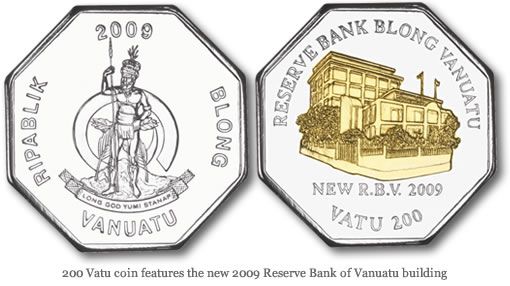To celebrate their new headquarters, the Reserve Bank of Vanuatu has released a set of coins illustrating their historic development into independent banking through the growth of the building itself.

Vanuatu is an archipelago based in the South Pacific. It was first inhabited by Melanesian people but Europeans began to settle in the area in the late 18th century.
In the 1880s France and the United Kingdom claimed parts of the country and in 1906 they agreed on a framework for jointly managing the archipelago as the New Hebrides through a British-French Condominium.
Gaining Independence from France and Britain in 1980, the Central Bank of Vanuatu (now known as the Reserve Bank of Vanuatu) began operations on 1st January 1981.
One of the first tasks of the Bank was to implement monetary reform and so from that day forth, the New Hebrides Franc was renamed the Vatu, from a local language word for stone. Initially, the activities of the Central Bank were limited to the issue and exchange of currency.
In February 1981, the Central Bank began making arrangements for the design and production of the new Vatu currency which would replace the New Hebrides Franc and the Australian currency that were in circulation. On 22nd March 1982 the Central Bank issued the new Vatu notes and from the 1st April 1983 the New Hebrides Franc and the Australian currency ceased to be legal tender.

The design on the reverse of the coin features a different Reserve Bank Building; the 50 Vatu coin shows the building that the Reserve Bank occupied when it began operations and was used from 1981 — 1989. In 1986, the Central Bank was allocated a suitable plot of land on the central hill overlooking Port Vila and its harbour to build its new home.
In February 1989 the Central Bank of Vanuatu moved into its new home and this building, used from 1990 — 2008, is shown on the 100 Vatu coin. The 200 Vatu coin features the new 2009 Reserve Bank of Vanuatu building. The obverse on each coin features the Vanuatu Coat of Arms and the coins have been produced by Pobjoy Mint for the Reserve Bank of Vanuatu in a special colour pack.
Vatu Coins Specifications:
| Metal | Diameter | Weight |
| Silverclad© & Goldclad© 200 Vatu | 35.00mm | 19.50gms |
| Silverclad© 100 Vatu | 29.00mm | 15.00gms |
| Silverclad© 50 Vatu | 26.00mm | 12.00gms |
Those interested in obtaining these packs should contact the Reserve Bank of Vanuatu, PMB 9062, Port Vila, Vanuatu.
# # #
About Pobjoy Mint Ltd.
 The Pobjoy family have been associated with fine metalwork since the Middle Ages. The Company was recently granted permission to use the family Coat of Arms in which the Medieval Popinjay is the central motif.
The Pobjoy family have been associated with fine metalwork since the Middle Ages. The Company was recently granted permission to use the family Coat of Arms in which the Medieval Popinjay is the central motif.
Over the past three centuries, the Company has been involved in many diverse fields, but they have always been involved in metal, both base and precious.
For the past 100 years the Company has been deeply involved in the development and manufacture of coins, medals and tokens.





